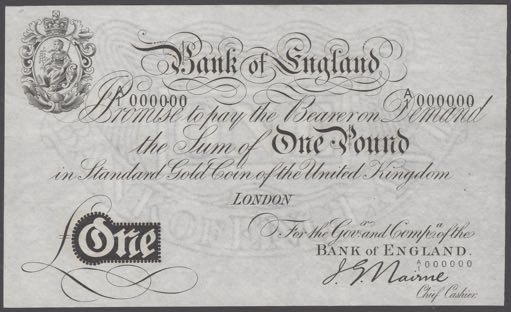Rare £5 banknote could make £12,000
A spectacular Bank of England £5 note dating from 28 December, 1863 is among the highlights of an online/ live auction of British, Irish and World Banknotes at Dix Noonan Webb on October 28. The auction house said it is probably the finest quality early black and white note the cataloguer has ever seen, it is signed by Matthew Marshall and is estimated at £10,000- 12,000.

As Andrew Pattison Head of Department, Banknotes at Dix Noonan Webb, explains: “when it was printed in 1863, this Marshall £5 represented the absolute height of Victorian technology. All of the recent advances in paper making, printing and watermarking, are all clearly visible in this beautiful banknote. In fact, this exact design was used until 1956 – a further 93 years and the fact that it has survived in this condition – almost as if it had been printed yesterday – is miraculous.”
Another important Bank of England note in the sale is a £1 ‘Gold Note’ dating from 1914, signed by John G. Nairne. With the serial number A/1 000000, this is an exceptional uncirculated example of this rare proof type – one of around only 15 to survive today – and carries an estimate of £6,000- 7,000.
The sale of 1060 banknotes includes examples from all over the world. One of the finest known examples of a Qatar & Dubai 100 Riyal – almost uncirculated and a classic rarity in this kind of condition is estimated at £9,000-12,000, while from the Government of Iraq, an impressive 100 Dinars note from 1936, with a magnificent portrait of King Ghazi is expected to fetch £10,000-15,000.

Elsewhere, from the Imperial Bank of Persia, is a wonderful and very fine example of a popular and rare denomination – the 3 Toman note dating from 2 July 1914, which is estimated at £4,000-£5,000. A rare and interesting fully issued 50 Dalere from the Danish West Indies, with six signatures, dated 1849 is expected to fetch £3,200- 3,800; while a large and impressive 10 Rupees issued by the East African Currency Board in 1916, in lovely original condition is estimated at £3,400-4,000.
A huge range of Portuguese and Portuguese colonial notes from all eight colonies, including some significant rarities will also be offered. From the Banco Nacional Ultramarino, Portuguese India, is a cancelled 10 Rupias, dating from 1 January 1906, with two large cancellation holes and blue bank handstamp on reverse (est: £2,000-2,600).
Among the British regional banknotes is an unissued £1 note from the Petersfield Bank. The note bears the names of bankers Austen, Blunt & Clement – the Austen in question being Henry Thomas Austen, the brother of author Jane Austen. It is estimated at £300- £400.


